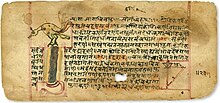Bhāskara II
Indian mathematician and astronomer (1114–1185)Bhāskara II, also known as Bhāskarāchārya, was an Indian polymath, mathematician, and astronomer. From verses in his main work, Siddhānta Śiromaṇi, it can be inferred that he was born in 1114 in Vijjadavida (Vijjalavida) and living in the Satpura mountain ranges of Western Ghats, believed to be the town of Patana in Chalisgaon, located in present-day Khandesh region of Maharashtra by scholars. In a temple in Maharashtra, an inscription supposedly created by his grandson Changadeva, lists Bhaskaracharya's ancestral lineage for several generations before him as well as two generations after him. Henry Colebrooke who was the first European to translate (1817) Bhaskaracharya's mathematical classics refers to the family as Maharashtrian Brahmins residing on the banks of the Godavari.



